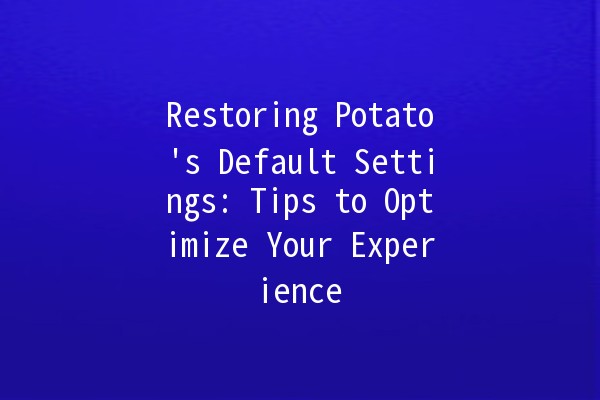When it comes to using the Potato software or application, users may find themselves needing a fresh start due to various reasons, whether it’s due to clutter, performance issues, or simply a desire to reset configurations to their original state. In this article, we will explore practical advice for restoring the default settings of Potato and enhancing your experience with it. We’ll cover five productivityboosting tips to help streamline your process and ensure you’re getting the most out of this application.
Understanding the Need for Default Settings
Restoring default settings can often resolve issues stemming from misconfigurations or unwanted changes. For instance, if you switched a feature and it isn't working as intended, or if you've simply customized settings to a point where they become confusing, resetting can help simplify the interface. Here’s why default settings matter:

Tip 1: Backup Your Current Settings First 📦
Before diving into restoring defaults, it’s critical to backup your current settings.
Explanation:
Backing up ensures that if the default settings do not meet your needs, you can always revert back. Many users override this step, leading to lost customizations that were beneficial.
Practical Application:
By ensuring you have a backup, you can experiment without fear of losing important configurations.
Tip 2: Clear Cache and Temporary Files 🗑️
Sometimes, residual files can cause settings to become corrupted or misaligned.
Explanation:
Clearing cache and temporary files can free up space and help the application run smoother, allowing for a cleaner restoration process.
Practical Application:
Windows:
Mac:
Clearing these files can improve Potato’s performance postreset.
Tip 3: Use Builtin Reset Features 🔄
Most software, including Potato, comes with builtin options to restore settings.
Explanation:
This method automates the process of resetting without needing to navigate multiple menus or perform complex actions.
Practical Application:
Utilizing builtin features can significantly streamline the process, ensuring that everything is set back to its original state.
Tip 4: Customize After Reset for Enhanced Productivity ⚡
Once you have restored Potato to its default settings, consider customizing only the settings that enhance your productivity.
Explanation:
Not all default settings are optimal for every user. After resetting, take the time to personalize aspects that will help you work more efficiently.
Practical Application:
By selectively customizing, you’ll create a workspace that is not only familiar but also enhances your productivity.
Tip 5: Reach Out for Support if Needed 📞
If you encounter issues during the resetting process, don’t hesitate to reach out for support.
Explanation:
User communities and official support channels can provide guidance, especially if you’re facing unique challenges.
Practical Application:
Getting help can ensure that you are not stuck and can return to using Potato effectively.
Common Questions About Restoring Potato's Default Settings
Restoring the default settings will erase any custom configurations you have made. This includes layout preferences, shortcuts, and userspecific settings. It's advisable to back up these settings beforehand.
No, restoring defaults typically affects only the application settings, not your files or data. Your saved files should remain intact postreset.
There isn’t a specific timeline for resetting, but consider it whenever you experience performance issues, frequent bugs, or if you've made numerous changes that have complicated usability.
Yes, most mobile applications have an option in the settings menu to restore default settings. The process may vary slightly, so refer to the specific documentation for mobile use.
Yes, provided that Potato supports shared settings files. You can send your backedup settings to others who can then import them into their software.
If Potato continues to crash after a reset, it may be a sign that you need to reinstall the application entirely or check for software updates that might address the issue.
By applying these tips and answering your common questions, you can make your experience with Potato more efficient and enjoyable. Resetting your settings can be a refreshing process, allowing you to regain control over your work environment. Take advantage of each suggestion to ensure a smooth transition back to a more organized and effective use of Potato’s features. Happy resetting!